PONTIAC G3 2009 Owners Manual
Manufacturer: PONTIAC, Model Year: 2009, Model line: G3, Model: PONTIAC G3 2009Pages: 348, PDF Size: 2.16 MB
Page 191 of 348

Run your engine only as long as you must. This saves
fuel. When you run the engine, make it go a little faster
than just idle. That is, push the accelerator slightly. This
uses less fuel for the heat that you get and it keeps the
battery charged. You will need a well-charged battery
to restart the vehicle, and possibly for signaling later on
with the headlamps. Let the heater run for a while.
Then, shut the engine off and close the window almost all
the way to preserve the heat. Start the engine again and
repeat this only when you feel really uncomfortable from
the cold. But do it as little as possible. Preserve the fuel
as long as you can. To help keep warm, you can get out
of the vehicle and do some fairly vigorous exercises
every half hour or so until help comes.If Your Vehicle is Stuck in Sand,
Mud, Ice, or Snow
Slowly and cautiously spin the wheels to free the
vehicle when stuck in sand, mud, ice, or snow. See
Rocking Your Vehicle to Get It Out on page 4-18.
{CAUTION:
If you let your vehicle’s tires spin at high speed,
they can explode, and you or others could be
injured. The vehicle can overheat, causing an
engine compartment �re or other damage. Spin the
wheels as little as possible and avoid going above
35 mph (55 km/h) as shown on the speedometer.
For information about using tire chains on the vehicle,
seeTire Chains on page 5-69.
4-17
Page 192 of 348
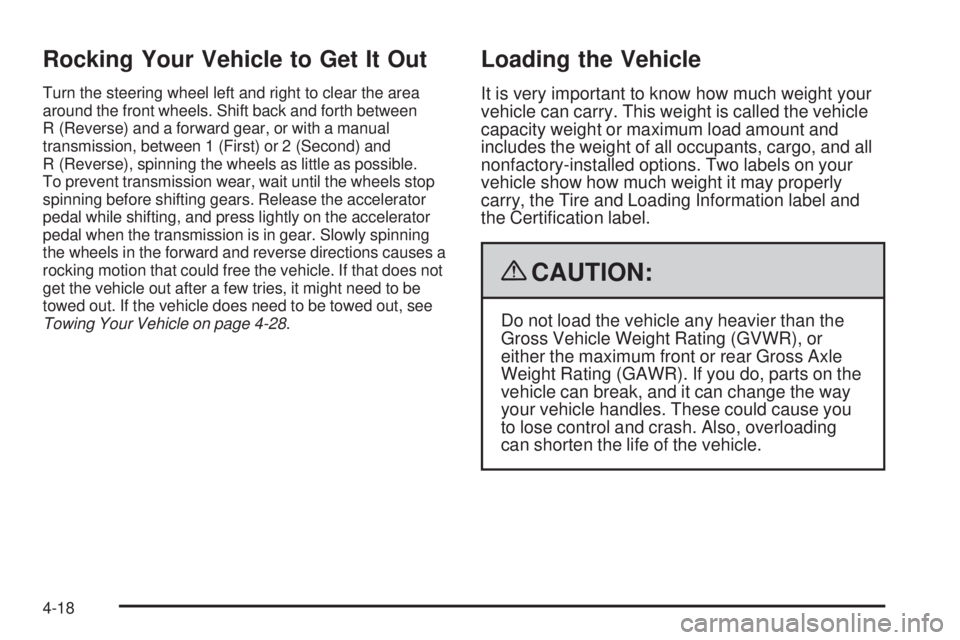
Rocking Your Vehicle to Get It Out
Turn the steering wheel left and right to clear the area
around the front wheels. Shift back and forth between
R (Reverse) and a forward gear, or with a manual
transmission, between 1 (First) or 2 (Second) and
R (Reverse), spinning the wheels as little as possible.
To prevent transmission wear, wait until the wheels stop
spinning before shifting gears. Release the accelerator
pedal while shifting, and press lightly on the accelerator
pedal when the transmission is in gear. Slowly spinning
the wheels in the forward and reverse directions causes a
rocking motion that could free the vehicle. If that does not
get the vehicle out after a few tries, it might need to be
towed out. If the vehicle does need to be towed out, see
Towing Your Vehicle on page 4-28.
Loading the Vehicle
It is very important to know how much weight your
vehicle can carry. This weight is called the vehicle
capacity weight or maximum load amount and
includes the weight of all occupants, cargo, and all
nonfactory-installed options. Two labels on your
vehicle show how much weight it may properly
carry, the Tire and Loading Information label and
the Certi�cation label.
{CAUTION:
Do not load the vehicle any heavier than the
Gross Vehicle Weight Rating (GVWR), or
either the maximum front or rear Gross Axle
Weight Rating (GAWR). If you do, parts on the
vehicle can break, and it can change the way
your vehicle handles. These could cause you
to lose control and crash. Also, overloading
can shorten the life of the vehicle.
4-18
Page 193 of 348
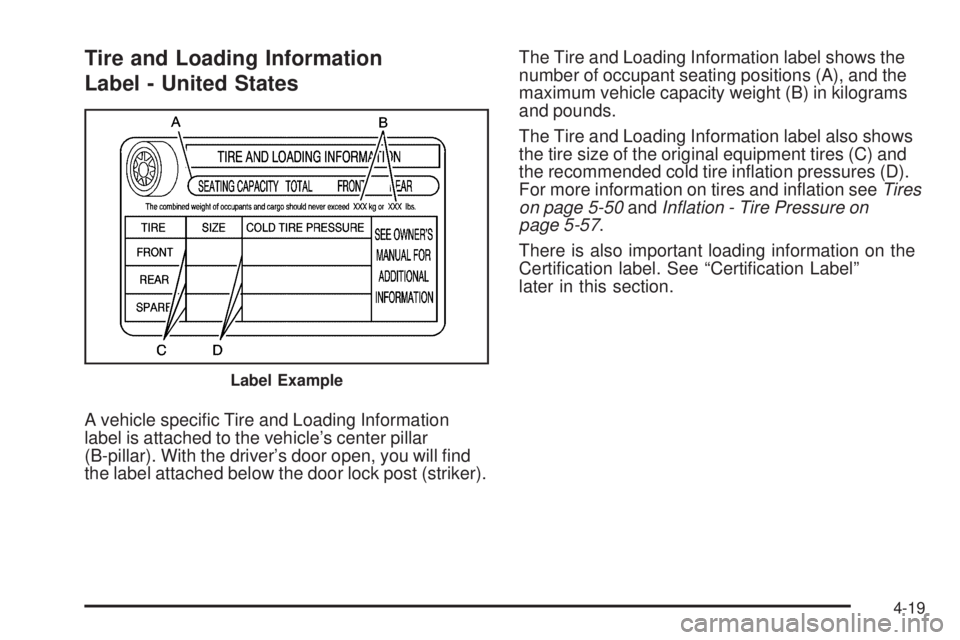
Tire and Loading Information
Label - United States
A vehicle speci�c Tire and Loading Information
label is attached to the vehicle’s center pillar
(B-pillar). With the driver’s door open, you will �nd
the label attached below the door lock post (striker).The Tire and Loading Information label shows the
number of occupant seating positions (A), and the
maximum vehicle capacity weight (B) in kilograms
and pounds.
The Tire and Loading Information label also shows
the tire size of the original equipment tires (C) and
the recommended cold tire in�ation pressures (D).
For more information on tires and in�ation seeTires
on page 5-50andInflation - Tire Pressure on
page 5-57.
There is also important loading information on the
Certi�cation label. See “Certi�cation Label”
later in this section.
Label Example
4-19
Page 194 of 348
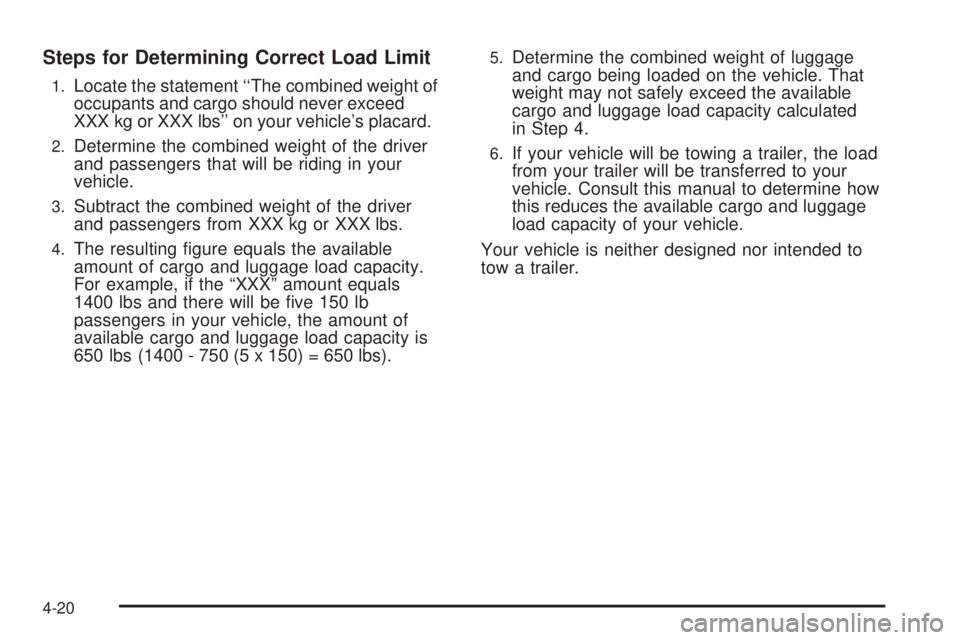
Steps for Determining Correct Load Limit
1.Locate the statement ‘‘The combined weight of
occupants and cargo should never exceed
XXX kg or XXX lbs’’ on your vehicle’s placard.
2.Determine the combined weight of the driver
and passengers that will be riding in your
vehicle.
3.Subtract the combined weight of the driver
and passengers from XXX kg or XXX lbs.
4.The resulting �gure equals the available
amount of cargo and luggage load capacity.
For example, if the “XXX” amount equals
1400 lbs and there will be �ve 150 lb
passengers in your vehicle, the amount of
available cargo and luggage load capacity is
650 lbs (1400 - 750 (5 x 150) = 650 lbs).
5.Determine the combined weight of luggage
and cargo being loaded on the vehicle. That
weight may not safely exceed the available
cargo and luggage load capacity calculated
in Step 4.
6.If your vehicle will be towing a trailer, the load
from your trailer will be transferred to your
vehicle. Consult this manual to determine how
this reduces the available cargo and luggage
load capacity of your vehicle.
Your vehicle is neither designed nor intended to
tow a trailer.
4-20
Page 195 of 348
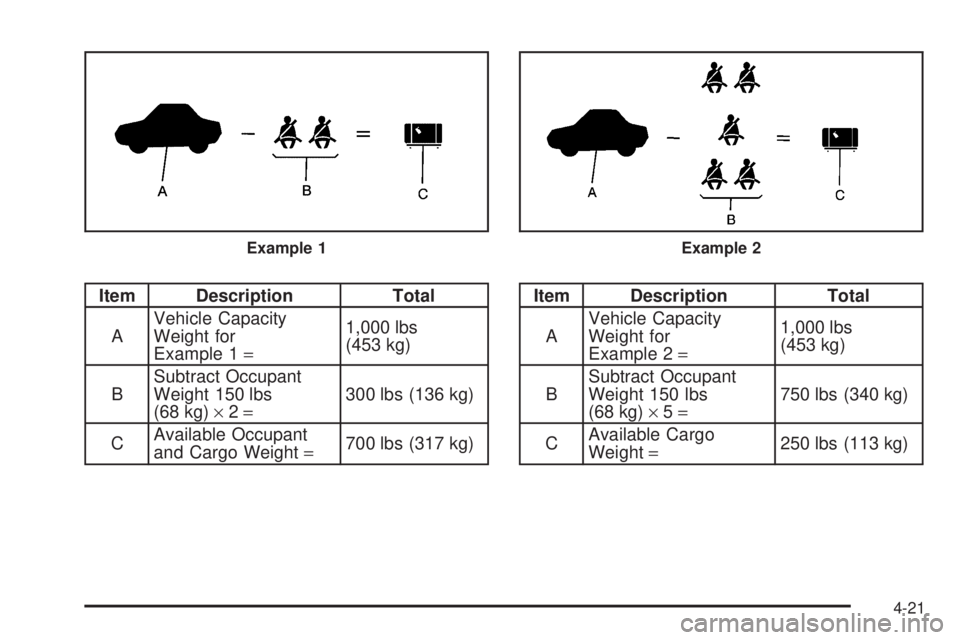
Item Description Total
AVehicle Capacity
Weight for
Example 1=1,000 lbs
(453 kg)
BSubtract Occupant
Weight 150 lbs
(68 kg)×2=300 lbs (136 kg)
CAvailable Occupant
and Cargo Weight=700 lbs (317 kg)Item Description Total
AVehicle Capacity
Weight for
Example 2=1,000 lbs
(453 kg)
BSubtract Occupant
Weight 150 lbs
(68 kg)×5=750 lbs (340 kg)
CAvailable Cargo
Weight=250 lbs (113 kg)
Example 1Example 2
4-21
Page 196 of 348
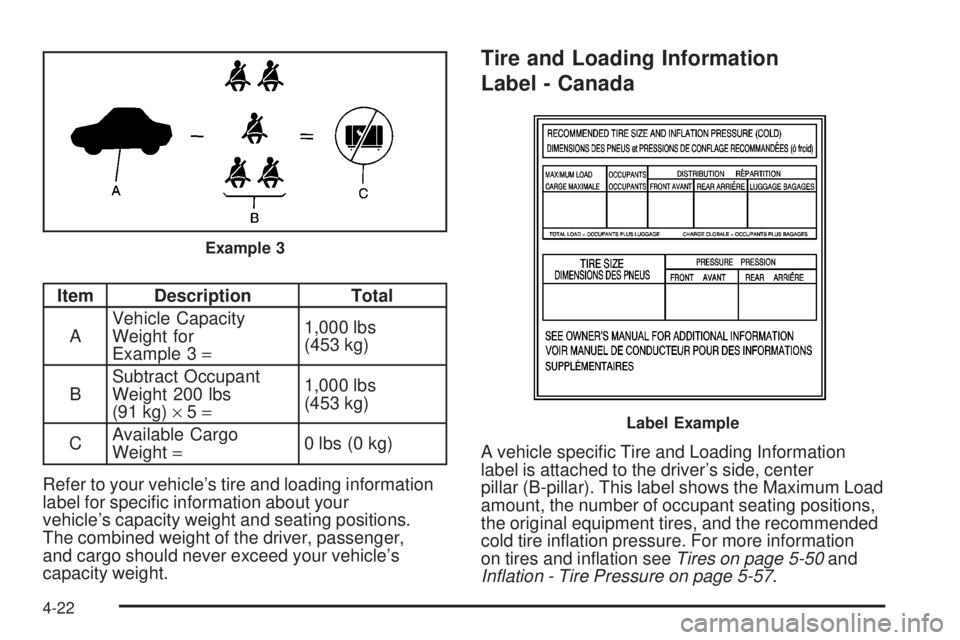
Item Description Total
AVehicle Capacity
Weight for
Example 3=1,000 lbs
(453 kg)
BSubtract Occupant
Weight 200 lbs
(91 kg)×5=1,000 lbs
(453 kg)
CAvailable Cargo
Weight=0 lbs (0 kg)
Refer to your vehicle’s tire and loading information
label for speci�c information about your
vehicle’s capacity weight and seating positions.
The combined weight of the driver, passenger,
and cargo should never exceed your vehicle’s
capacity weight.
Tire and Loading Information
Label - Canada
A vehicle speci�c Tire and Loading Information
label is attached to the driver’s side, center
pillar (B-pillar). This label shows the Maximum Load
amount, the number of occupant seating positions,
the original equipment tires, and the recommended
cold tire in�ation pressure. For more information
on tires and in�ation seeTires on page 5-50and
Inflation - Tire Pressure on page 5-57.
Example 3
Label Example
4-22
Page 197 of 348
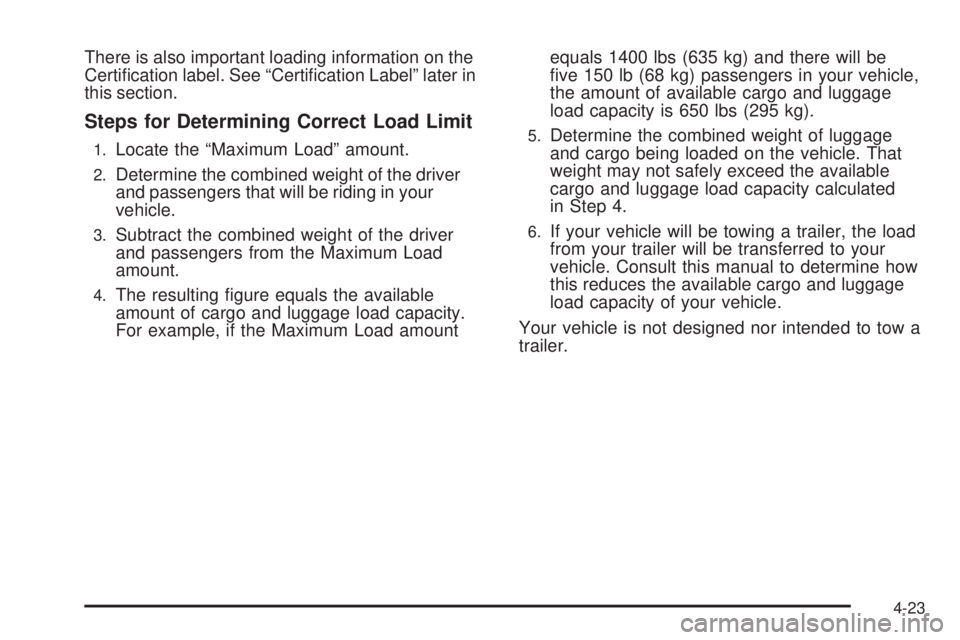
There is also important loading information on the
Certi�cation label. See “Certi�cation Label” later in
this section.
Steps for Determining Correct Load Limit
1.Locate the “Maximum Load” amount.
2.Determine the combined weight of the driver
and passengers that will be riding in your
vehicle.
3.Subtract the combined weight of the driver
and passengers from the Maximum Load
amount.
4.The resulting �gure equals the available
amount of cargo and luggage load capacity.
For example, if the Maximum Load amountequals 1400 lbs (635 kg) and there will be
�ve 150 lb (68 kg) passengers in your vehicle,
the amount of available cargo and luggage
load capacity is 650 lbs (295 kg).
5.Determine the combined weight of luggage
and cargo being loaded on the vehicle. That
weight may not safely exceed the available
cargo and luggage load capacity calculated
in Step 4.
6.If your vehicle will be towing a trailer, the load
from your trailer will be transferred to your
vehicle. Consult this manual to determine how
this reduces the available cargo and luggage
load capacity of your vehicle.
Your vehicle is not designed nor intended to tow a
trailer.
4-23
Page 198 of 348
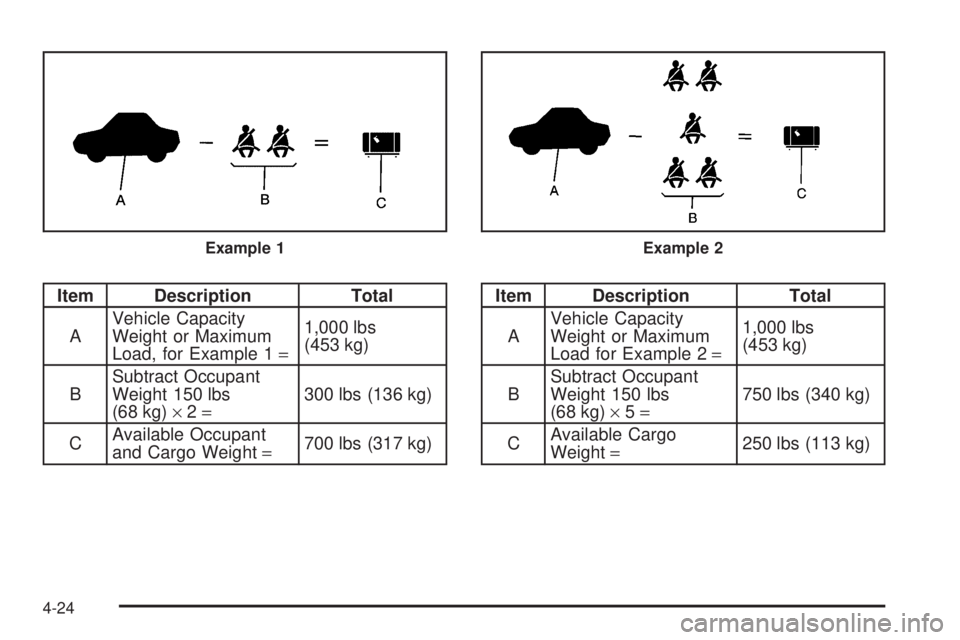
Item Description Total
AVehicle Capacity
Weight or Maximum
Load, for Example 1=1,000 lbs
(453 kg)
BSubtract Occupant
Weight 150 lbs
(68 kg)×2=300 lbs (136 kg)
CAvailable Occupant
and Cargo Weight=700 lbs (317 kg)Item Description Total
AVehicle Capacity
Weight or Maximum
Load for Example 2=1,000 lbs
(453 kg)
BSubtract Occupant
Weight 150 lbs
(68 kg)×5=750 lbs (340 kg)
CAvailable Cargo
Weight=250 lbs (113 kg)
Example 1Example 2
4-24
Page 199 of 348
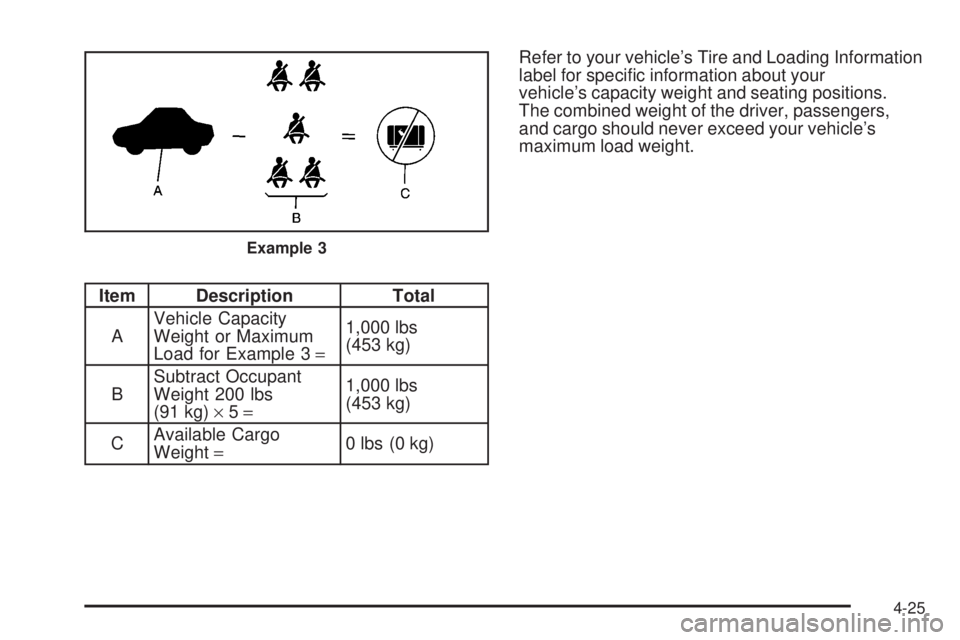
Item Description Total
AVehicle Capacity
Weight or Maximum
Load for Example 3=1,000 lbs
(453 kg)
BSubtract Occupant
Weight 200 lbs
(91 kg)×5=1,000 lbs
(453 kg)
CAvailable Cargo
Weight=0 lbs (0 kg)Refer to your vehicle’s Tire and Loading Information
label for speci�c information about your
vehicle’s capacity weight and seating positions.
The combined weight of the driver, passengers,
and cargo should never exceed your vehicle’s
maximum load weight.
Example 3
4-25
Page 200 of 348
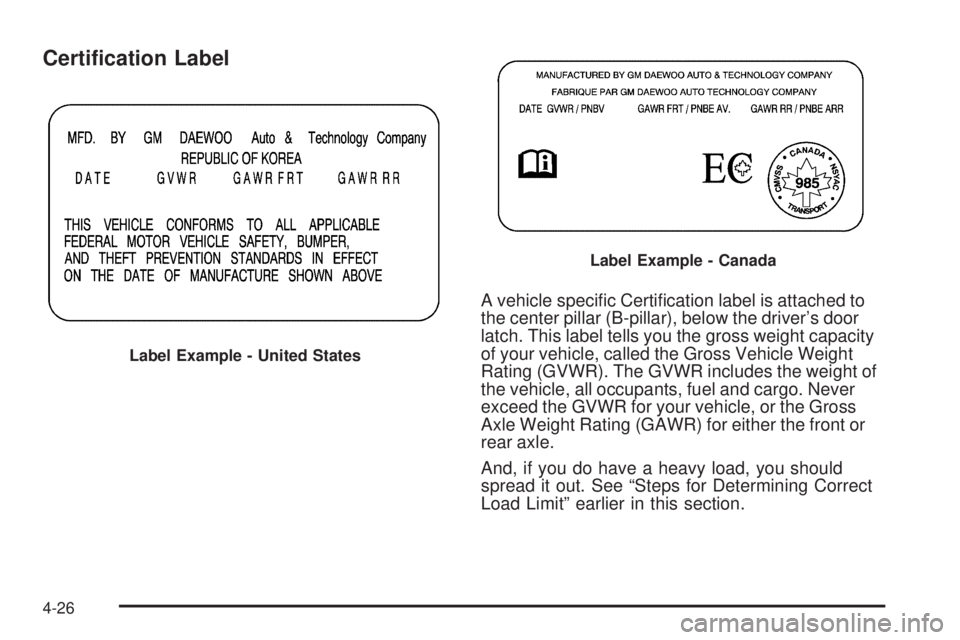
Certi�cation Label
A vehicle speci�c Certi�cation label is attached to
the center pillar (B-pillar), below the driver’s door
latch. This label tells you the gross weight capacity
of your vehicle, called the Gross Vehicle Weight
Rating (GVWR). The GVWR includes the weight of
the vehicle, all occupants, fuel and cargo. Never
exceed the GVWR for your vehicle, or the Gross
Axle Weight Rating (GAWR) for either the front or
rear axle.
And, if you do have a heavy load, you should
spread it out. See “Steps for Determining Correct
Load Limit” earlier in this section.
Label Example - United States
Label Example - Canada
4-26